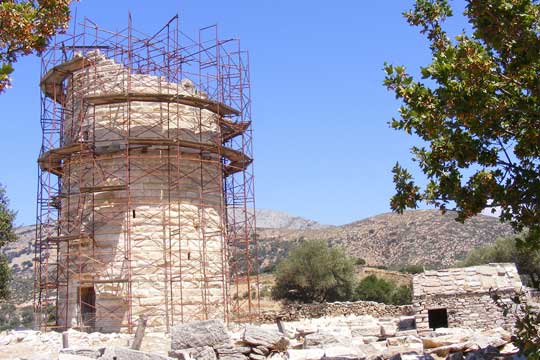Cheimarros, Naxos, Cyclades,South Aegean
Cheimarros Tower
| Location: |
| In a remote area of SE Naxos island, on top of a hill between the settlements Argiovessa and Vardakis |
| Region > Prefecture: |  |
| South Aegean Cyclades | |
| Municipality > Town: | |
| City of Naxos • Cheimarros | |
| Altitude: | |
| Elevation ≈ 350 m |
| Time of Construction | Origin | |
| 4th or 5th cent. BC | ANCIENT |
|
| Castle Type | Condition | |
| Ancient Tower |
Average
|
This is one of the most important monuments of Naxos, and, like the gate of the archaic temple of Apollo, known as Portara, a trade mark of the island. The monument is situated on the southeastern side of the island, half way between Zas, the highest mountain of Naxos, and the sea, on a hill between two ravines, Heimarros to the east and Petronia to the west.
Similar towers have a wide distribution in the Aegean, but in the majority of cases only the foundations are still visible. The tower oh Heimarros is a very rare exception, standing to the impressive height of almost 15 m. It is better preserved externally, whereas internally large parts of the masonry have fallen or are about to collapse. The tower has a circular plan; its external diameter is 9.20m. and the internal 7.12m. The walls have a thickness of 1.10m., they are made of local marble, without the use of mortar, and they are double faced. The high quality of the ancient masonry is evident.
This tower, most probably, was still in use during the Middle Ages, as a watchtower or a shelter in the age of piracy.
Structure, Fortification & Buildings
The stones forming the inner face of the wall are quite irregular in size, and are chiseled only on their horizontal sides. On the south side there is a door and straight above it, 10m. from the ground, on the level of the second floor, there is a window. The only other openings are some waterspouts and loopholes, which from the outside appear as mere narrow slits, widening inside to facilitate the movements of archers.
The tower was internally divided into four floors above the ground and their position can be inferred from the preserved beam holes. To the left of the entrance a staircase, with marble steps embedded in the wall, leads clockwise to the upper floors. The top of the tower has fallen away, and although there is no evidence yet, some scholars assume that the roof would have been flat and probably surrounded by battlements.
The tower stands within an almost square enclosed wall, measuring about 35m. on each side. It is better preserved in the south and most of the western and eastern sides, whereas parts of the northern side have been incorporated in later constructions. The wall is 1m. thick, reaching 2m. in height and its outer face is built with rectangular stones of various sizes. The whole of the internal and a large part of the outer face is covered by drift earth and is therefore invisible. No towers or other subsidiary buildings have been noted.
Collateral stories
Similar towers, either circular or rectangular, are abundant in the Aegean. Several are known from Naxos itself, the best preserved being at Plaka. On Siphnos, as a result of a systematic survey more than fifty towers have been recorded. Seventy-three are known so far from Kea, while several have been noted on Kythnos, Serifos, Amorgos, Myconos, Paros and Tenos. At the present stage of research it is still difficult to define their precise dating and function. According to a long standing view they were either watch towers or places of refuge for the population during the turbulent Hellenistic times. However, some were already constructed in the 6th century B.C. and their function must therefore vary according to the period and the location.
A military installation of this magnitude, however, can hardly be considered the work of peasants and it may have formed part of a centrally organized defensive system. The monument had been recorded by early travellers; a brief study by the British archaeologist J.P. Droop was published in 1923.
| First entry in Kastrologos: | November 2012 |
Sources
- Website ΟΔΥΣΣΕΥΣ - Greek ministry of Culture Pyrgos Chimarrou
|
|
| Access |
|---|
| Approach to the monument: |
| - |
| Entrance: |
| ? |





